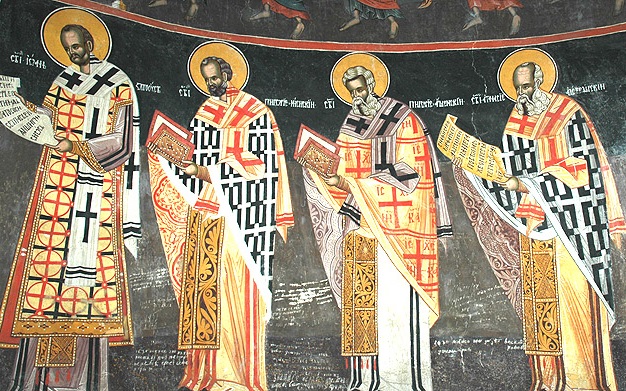
“Greet one another with an holy kiss. All the saints salute you.” (2 Corinthians 13:12)
The priest exhorts, “Let us love one another…” just before reading the Creed. It might sound simple and clear: love for one’s neighbor is the main substance of Christian life, which is why it is so important to hear this call of love before professing the truths of our faith, followed by the main Sacrament of the Church and the most important part of the Liturgy: the Holy Eucharist. Things weren’t so straightforward in the Ancient Church. People would respond to this call with a concrete action, a special rite: they exchanged holy kisses. What is this rite and what place did it occupy in the Ancient Church? Should we revive it?
The custom of kissing one another as a way of greeting and saying goodbye was widespread in the ancient world among many peoples, including the Jews. This friendly gesture is still in place in various countries and does not cause any misunderstanding. This kind of greeting was also accepted by the Christians, both in their everyday lives and in their liturgical services. There are five passages in the Scripture, mainly in the epistles of the Apostle Paul, where he urges us to greet our brothers in Christ with the “holy kiss” (2 Corinthians 3:12; 1 Thessalonians 5:26). Apostle Peter calls for greeting each other with “the kiss of love” (1 Peter 5:14). It was customary to greet guests with a kiss, thus showing hospitality and respect. We remember that the Lord reproached Simon the Pharisee, “Thou gavest me no kiss” (Luke 7:45), even though Jesus had often contested the importance of strict adherence to all the rules and customs. It is probable that a cordial kiss was more precious in the Savior’s eyes than washing hands before a meal. Judas betrayed Christ with a kiss, which indicates that it was a customary way of saying hello for the Lord and his disciples.
Why was this custom also practiced at the most important Christian worship service, the Holy Eucharist? Wasn’t it more important to focus solely on prayer and not be distracted by kissing people in attendance, especially since everyone had probably greeted each other already before the Liturgy?

As we have already mentioned, the Eucharist is the Sacrament of Love in the first place: that of the Creator to his creation, reciprocated by love and thanksgiving of the faithful. That is why people exchanged holy kisses at the Liturgy as a visible manifestation of brotherly love required for proper participation in the Frightful Mystery. However, not only the Eucharist was accompanied by the kissing of love; this rite was an integral part of other Sacraments associated with the Eucharist. For instance, it was performed after Baptism: the bishop kissed the christened person saying, “The Lord is with you.” The consecration of a new bishop was also accompanied with the kisses in the Name of the Lord by all clergy and laymen, after which he carried out his first Eucharistic offering. It is customary to give the “last kiss” to newly deceased Christians. As we can see, this rite accompanied the Christian throughout his life. However, the primary occasion for this rite was still the Eucharist. A holy kiss is not only a visible expression of love for one’s neighbor, but also an indication of forgiveness of offenses and a sign of reconciliation. Christians took the Lord’s words very seriously, “Therefore if thou bring thy gift to the altar, and there rememberest that thy brother hath ought against thee; Leave there thy gift before the altar, and go thy way; first be reconciled to thy brother, and then come and offer thy gift.” (Matthew 5:23-24). The kiss of love was the way to ask forgiveness and reconciliation from your neighbor, so as to receive the Holy Communion of Christ without reproach. In the Ambrosian Rite, Christ’s call to bring a gift to God only after making peace with one another is observed literally, for in this rite the mutual kissing of peace occurs just before the bread and wine are laid on the Holy Table. In the Byzantine Rite, the kiss of peace occurred before the collective confession of the Orthodox faith immediately before the beginning of the Holy Anaphora.
How is it that such an important action has fallen out of our liturgical use? Well, it did not disappear; its use has shrunk to the sanctuary, while the faithful only exchange kisses on Easter. Most likely, this greeting was more appropriate in small congregations, where everyone knew each other. And yet, in our age of individualism, it is worth reflecting on the rebirth of this beautiful custom, which can fill the Church with warmth and friendly atmosphere, soften our hearts and bring our parishioners closer together. If someone doesn’t want to kiss a stranger, one can just shake hands, make a little bow, or just smile, because we are all brothers and sisters in Christ. We have to acknowledge that we came to the Church to attend the Liturgy as our Common Cause, not for private needs. We are not here in our own right; rather, we make up the Body of Christ composed of scattered members. Every Sunday, every Liturgy is Easter, the invisible presence of the Risen One. “Let us love one another”, for “Christ is in our midst”. May these words be more deeply imprinted in our thoughts and may the kiss of love serve as a good reminder of this.



